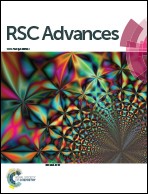Hierarchical porous carbon derived from recycled waste filter paper as high-performance supercapacitor electrodes
Abstract
Hierarchical activated porous carbon (APC) was synthesized through convenient chemical activation with ZnCl2 using recycled waste filter paper as the carbon precursor. The micro/mesopore ratio, pore volume and specific surface area of these APC materials could be controlled by adjusting the dosage of the ZnCl2 chemical agent and the activation temperature. The optimal sample, APC-7-4, was activated at 700 °C with a ZnCl2/carbon precursor mass ratio of 4 : 1, and exhibited a large surface area of 2169.8 m2 g−1, a suitable pore size and prominent porosity. Remarkably, when the resultant APC-7-4 material acted as the electrode material for a supercapacitor, APC-7-4 displayed an outstanding charge storage capacity with a satisfactory specific capacitance of 302.3 F g−1 in 6 M KOH at a current density of 1 A g−1. Moreover, the APC-7-4 electrode possessed good long-term cycling stability, and ca. 95.4% of its initial specific capacitance at 5 A g−1 was retained even after 10 000 cycles. Based on these electrochemical test results, the approach proposed in this work provides a new view of converting waste products to design high-performance carbon-based electrode materials for great and promising applications in electric double-layer capacitors.


 Please wait while we load your content...
Please wait while we load your content...